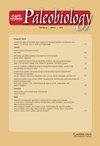The Fractional MacroEvolution Model: a simple quantitative scaling macroevolution model
IF 2.7
2区 地球科学
Q2 BIODIVERSITY CONSERVATION
引用次数: 0
Abstract
Scaling fluctuation analyses of marine animal diversity and extinction and origination rates based on the Paleobiology Database occurrence data have opened new perspectives on macroevolution, supporting the hypothesis that the environment (climate proxies) and life (extinction and origination rates) are scaling over the “megaclimate” biogeological regime (from ≈1 Myr to at least 400 Myr). In the emerging picture, biodiversity is a scaling “crossover” phenomenon being dominated by the environment at short timescales and by life at long timescales with a crossover at ≈40 Myr. These findings provide the empirical basis for constructing the Fractional MacroEvolution Model (FMEM), a simple stochastic model combining destabilizing and stabilizing tendencies in macroevolutionary dynamics, driven by two scaling processes: temperature and turnover rates. Macroevolution models are typically deterministic (albeit sometimes perturbed by random noises) and are based on integer-ordered differential equations. In contrast, the FMEM is stochastic and based on fractional-ordered equations. Stochastic models are natural for systems with large numbers of degrees of freedom, and fractional equations naturally give rise to scaling processes. The basic FMEM drivers are fractional Brownian motions (temperature,分数宏观进化模型:一种简单的定量缩放宏观进化模型
根据古生物数据库的发生数据,对海洋动物多样性以及灭绝和起源率进行了缩放波动分析,为宏观进化开辟了新的视角,支持了环境(气候代用指标)和生命(灭绝和起源率)在 "巨气候 "生物地质体系(从≈1 Myr到至少400 Myr)中缩放的假说。在新出现的图景中,生物多样性是一种按比例的 "交叉 "现象,在短时间尺度上由环境主导,在长时间尺度上由生命主导,在≈40 Myr时出现交叉。这些发现为构建 "分数宏观进化模型"(FMEM)提供了经验基础。FMEM 是一个简单的随机模型,结合了宏观进化动态中的不稳定和稳定趋势,由温度和更替率这两个缩放过程驱动。宏观进化模型通常是确定性的(尽管有时会受到随机干扰),并以整序微分方程为基础。相比之下,FMEM 是随机的,基于分数有序方程。对于具有大量自由度的系统来说,随机模型是很自然的,而分数方程自然会产生缩放过程。FMEM 的基本驱动力是分数布朗运动(温度,T)和分数高斯噪声(周转率,E+),而响应(解)则是分数积分分数弛豫噪声(多样性 [D]、灭绝 [E]、起源 [O] 和 E- = O - E)。我们讨论了脉冲响应(本身代表了模型对螺栓撞击的响应),并推导出模型的全部统计特性。通过对模型进行数值求解,我们验证了数学分析,并将均匀和不规则采样的模型输出与古生物学序列进行了比较。
本文章由计算机程序翻译,如有差异,请以英文原文为准。
求助全文
约1分钟内获得全文
求助全文
来源期刊

Paleobiology
地学-古生物学
CiteScore
5.30
自引率
3.70%
发文量
38
审稿时长
>12 weeks
期刊介绍:
Paleobiology publishes original contributions of any length (but normally 10-50 manuscript pages) dealing with any aspect of biological paleontology. Emphasis is placed on biological or paleobiological processes and patterns, including macroevolution, extinction, diversification, speciation, functional morphology, bio-geography, phylogeny, paleoecology, molecular paleontology, taphonomy, natural selection and patterns of variation, abundance, and distribution in space and time, among others. Taxonomic papers are welcome if they have significant and broad applications. Papers concerning research on recent organisms and systems are appropriate if they are of particular interest to paleontologists. Papers should typically interest readers from more than one specialty. Proposals for symposium volumes should be discussed in advance with the editors.
 求助内容:
求助内容: 应助结果提醒方式:
应助结果提醒方式:


